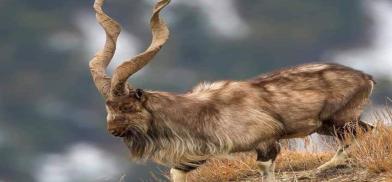'Infiltrators' who get royal treatment on both sides of India-Pakistan LoC
They “violate” the otherwise volatile Line of Control (LoC) at their own sweet will, but far from being challenged for their “infiltration”, they are treated as guests of honor on both sides of a disputed frontier – India and Pakistan

They “violate” the otherwise volatile Line of Control (LoC) at their own sweet will, but far from being challenged for their “infiltration”, they are treated as guests of honor on both sides of a disputed frontier – India and Pakistan. They are the markhors, screw-horned goats, the national animal of Pakistan.
Surrounded by coniferous forests with deodar trees and located along the Line of Control, the de facto border in Kashmir, Kazinag National Park in the Limber area of north Kashmir’s Boniyar sector in India is the home to the markhors.
“Due to its geographical distribution and the landscape, the animal can be found in Pir Panchal range and Kazinag National Park too. There are no borders for them. They keep coming to this side and going to the other side for breeding,” Dr Reyaz Ahmad, Coordinator, Wildlife Trust of India for Kashmir, said.
However, because of the border tensions between India and Pakistan, fencings have come up, and vigil is strong on the borders. “It may have affected free movement of markhors,” Reyaz was quoted as saying in Indiatimes.com
The animals generally come down from higher altitudes and cross the terrain during their breeding season - November 1 to mid-January.
The markhors are a large Capra species native to Central Asia, Karakoram and the Himalayas and generally found on mountainous terrain, between heights of 600 and 3,600 m inhabiting scrub forests made up primarily of oaks, pines and junipers.
The name “markhor” is a combination of two Persian and Pashto words - “mar” means snake and “khor” means eater. This has given rise to the old belief that markhors kill snakes, but that has been doubted by a large section of experts.
They stand 65 to 115 centimetres at the shoulder, 132 to 186 centimetres in length and weigh from 32 to 110 kilograms. While the females and the young live in flocks, males generally lead a solitary life.
The most spectacular feature of the markhors is their curled, corkscrew-like horns, which bond at the head, but spread upwards towards the tips. The horns can grow up to 160 cm long in males, and up to 25 cm in females.
There is a theory that markhors are the ancestor of some breeds of domestic goat, like the Angora goat.
These mammals are listed on the International Union for Conservation of Nature (IUCN) Red List as a near-threatened species since 2015.
They are hunted for their meat and killed for the Incredibly rare spiral horns, which are thought to have medicinal properties. Moreover, the markhors are exposed to natural disasters such as floods, land sliding and rolling stones.
According to the KPK Wildlife report, in 1993 there were 275 animals throughout Pakistan. But after some strict measures through the years to stop their killings, the markhor population has risen to 3500. In Pakistan. So Pakistan has requested IUCN to remove their name from the red list.
According to folklore because of their horns, the markhor has special abilities, such as being an eater or killer of snakes. After chewing its cud, the markhor has a foam-like substance that drips from its mouth. There is always a rush among the locals for the foam, as they believe it can be used for extracting snake poison.
Pakistan’s spy agency Inter-Services Intelligence (ISI) has chosen Markhor as their official symbol, Pakistan International Airlines (PIA) has also decided the markhor as the logo on the tail of every PIA
Amid the frequent reports of cross-border clashes, diplomatic spats, military accusations and counter-accusations between quarreling neighbors India and Pakistan, markhors have mercifully been spared.
Reyaz said there were plans to hold a peace pact between the two nations to save the markhors. “We are planning to do a peace pact with Pakistan so as to save the animal. On many occasions, they get injured or killed due to cross-border shelling.”
(SAM)








Post a Comment